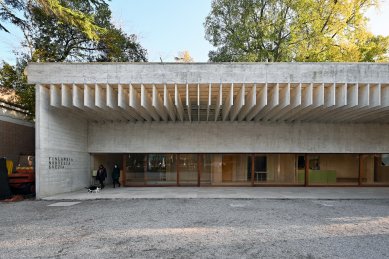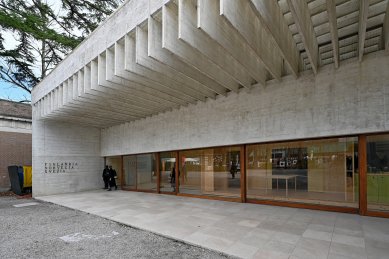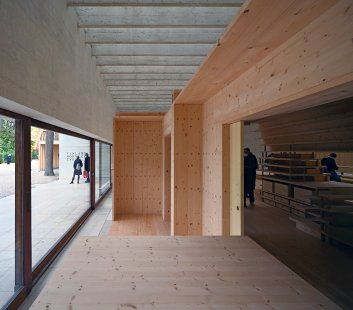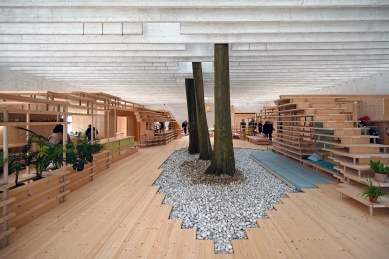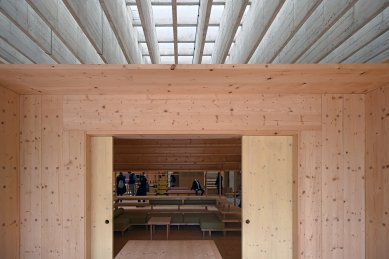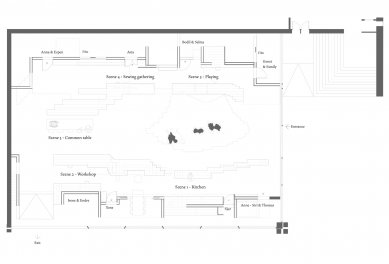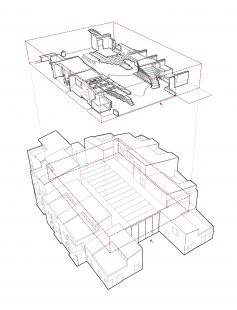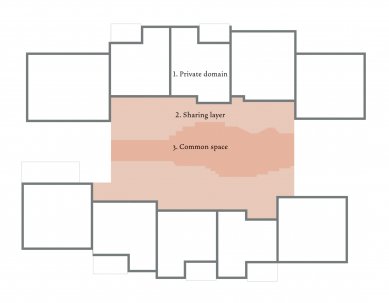
What we share
A model for cohousing

The installation “What we share” is a vision of a sustainable future model for how to build a community and a living environment simultaneously, a place where inhabitants are shareholders and active agents for the development of their residence and what they share. It explores relations between the co-creation of a spatial, material and tectonic living environment, while giving rise to an awareness for what and how we want to share with one another.
The experimental co-housing installation is based on Vindmøllebakken, a unique housing project based on resident participation and sustainable solutions designed by Helen & Hard, realized in 2018.
Building on the Nordic cohousing model, it combines self-ownership and independent housing units with shared functions and community life. This model was first developed in the Nordic countries in the 1970s and has since spread around the world.
The installation at the Nordic Pavilion showcases a full-scale section of the first floor of a co-living housing project that includes three interrelated zones. A participatory design process with the current inhabitants of Vindmoellebakken has contributed to the design of the three zones:
1. The private domain and how this can relate to the shared spaces and what parts of the private zone can be shared. 2. A sharing layer in front of the apartment that reflects what and how the inhabitants of each apartment want to share and which collective activities they want to unfold. 3. A central common space where all the inhabitants can meet that expresses the common interests and desires.
The layered space offers different degrees of privacy and communality, and various options to circulate and dwell undisturbed. The entire spatial organization of the cohousing model is parametrized in order to make changes and user participation affordable.
The walls and ceiling of the installation are built from an innovative timber system that consists of solid wooden planks in spruce, that are connected with beech dowels. It is a flexible, environmentally friendly modular system that is easy to assemble and use by the inhabitants to build and rebuild the private and shared structures. Thus making the proposition sustainable and susceptible to change over time. The timber structure is developed in close collaboration with the Swiss engineer Hermann Blumer.
Set within the famous pavilion, originally designed by Sverre Fehn in 1959, the structure has been conceived with this site in mind. The low landscape-like installation relates spatially to the ground in order to keep the characteristic light effect of the roof with its fragile brise-soleil in best order. The central common space is designed around the trees and opens up to both entrances. The horizontal shelf – like timber structure creates a sensual dialogue to the white concrete ribs in the roof and at the same time relates to the trunk of the three trees.
The basilica-inspired spatial organization together with the vast roof-structure encourages a contemplative, evocative atmosphere and an environment where the visitor can sensually and intuitively explore the various layers, narratives and atmospheres of the installation.
The experimental co-housing installation is based on Vindmøllebakken, a unique housing project based on resident participation and sustainable solutions designed by Helen & Hard, realized in 2018.
Building on the Nordic cohousing model, it combines self-ownership and independent housing units with shared functions and community life. This model was first developed in the Nordic countries in the 1970s and has since spread around the world.
The installation at the Nordic Pavilion showcases a full-scale section of the first floor of a co-living housing project that includes three interrelated zones. A participatory design process with the current inhabitants of Vindmoellebakken has contributed to the design of the three zones:
1. The private domain and how this can relate to the shared spaces and what parts of the private zone can be shared. 2. A sharing layer in front of the apartment that reflects what and how the inhabitants of each apartment want to share and which collective activities they want to unfold. 3. A central common space where all the inhabitants can meet that expresses the common interests and desires.
The layered space offers different degrees of privacy and communality, and various options to circulate and dwell undisturbed. The entire spatial organization of the cohousing model is parametrized in order to make changes and user participation affordable.
The walls and ceiling of the installation are built from an innovative timber system that consists of solid wooden planks in spruce, that are connected with beech dowels. It is a flexible, environmentally friendly modular system that is easy to assemble and use by the inhabitants to build and rebuild the private and shared structures. Thus making the proposition sustainable and susceptible to change over time. The timber structure is developed in close collaboration with the Swiss engineer Hermann Blumer.
Set within the famous pavilion, originally designed by Sverre Fehn in 1959, the structure has been conceived with this site in mind. The low landscape-like installation relates spatially to the ground in order to keep the characteristic light effect of the roof with its fragile brise-soleil in best order. The central common space is designed around the trees and opens up to both entrances. The horizontal shelf – like timber structure creates a sensual dialogue to the white concrete ribs in the roof and at the same time relates to the trunk of the three trees.
The basilica-inspired spatial organization together with the vast roof-structure encourages a contemplative, evocative atmosphere and an environment where the visitor can sensually and intuitively explore the various layers, narratives and atmospheres of the installation.
Helen & Hard
0 comments
add comment



